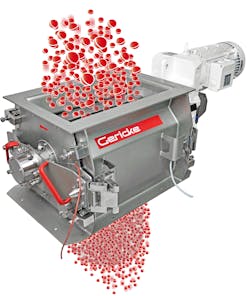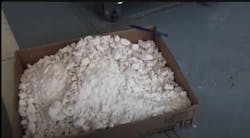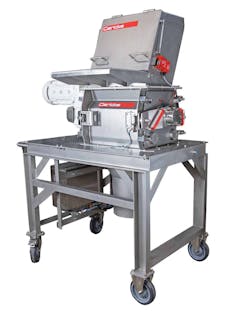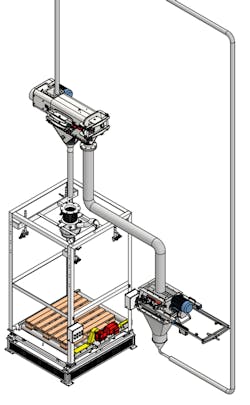Clever use of size reduction equipment eliminates waste, saves energy and cuts costs

It is well understood among processors that a wide variety of powders, pellets and other bulk materials agglomerate into clumps during transit and storage as heat and humidity levels rise and fall and rise again. It is also well understood that installing a lump breaker immediately downstream from a bulk bag unloader, silo or other storage unit neatly returns the agglomerates to powder for smooth transfer to a hopper, feeder or other equipment. But many processors are overlooking a diverse range of other opportunities to use lump breakers in their dry processes, and it may be costing them thousands of dollars every day.
Waste reprocessing
Consider that a major manufacturer of the dietary amino acid threonine produces 10 kg/hour of oversized, chalky chunks of the white material that fail to meet particle size specifications and simply discards all of this material as waste. In relation to the size of the batch and the capabilities of the processing line, the volume of off-spec material is deemed acceptable. The disposal costs and housekeeping headaches to collect, store, and manage this level of waste generation are dismissed as insignificant. But we can calculate the cost and let each reader decide its significance.
The company can sell its on-spec threonine for approximately $3.10/kg. Producing 10 kg/hour in two eight-hour shifts per day yields a revenue potential of $3.10 x 16 hours = $496.00 per day — if the material could be captured and reprocessed. Multiplying by an average of 25 operating days per month yields a revenue potential of $12,400.00/month, which translates to a fairly significant $148,800.00 of untapped annual revenue that recurs every year.
The owners, busy running a growing company, had not realized that it was now both possible and viable to collect and reprocess this waste material using new size-reduction technology. The latest lump breakers use a low speed, high-torque, rotating paddle assembly that cuts the material like an impact mill but without generating high heat or excessive fines. The machines also shear the material through a screen via attrition milling but without any metal-to-metal contact, virtually eliminating the potential for explosive or combustible dust events.
Presented with the case for saving $148,800.00 every year, the company installed a new lump breaker and diverted the waste material from random cardboard boxes to a collection bin for transfer to a hopper above the deagglomerating machine. Running continuously alongside the production process or in an on-demand batch setting, the lump breaker accepts the material at the infeed and automatically cuts it down to the uniform particle size required, then discharges it into the primary hopper to be mixed with the virgin material. Though the off-spec material comprises a wide range of particle shapes and sizes at the infeed, from fine powder to jagged bits exceeding two cubic inches in volume, the material exits the lump breaker at a uniform 1 millimeter in size.
At an approximate one-time cost of $60,000.00, this project paid for itself in five months. As added bonuses, the project also eliminated disposal costs, improved workplace cleanliness, reduced the company's impact on the environment and cut raw material costs.
Waste repurposing
In many cases, the waste material generated by a process differs too greatly from the input material to be returned to the process without clogging the equipment, compromising the product quality or altering the very nature of the product. A modern brewery, for example, produces some type of waste at every step in the process. Grinding grains and malted barley generates husks and other dry debris; mashing leaves spent grains; boiling leaves spent hops; and fermenting leaves yeast and other solids. None of this waste can be reused to brew beer, and all of it is usually discarded as waste.
The owner of a forward-thinking brewery evaluated the volume and components of the brewery's waste stream and concluded that most of it offered little value to anyone, but the spent grains from mashing and the yeast mixed with proteins and other solids generated during the fermentation process could be repurposed as animal feed.
The yeast mixture is discharged from the vessel as a foam. Instead of being discarded, the foam is settled, collected and dried in a drum dryer. Since the particle size of the dried material ranges from powders to granules and small agglomerates, the material is fed through a lump breaker, discharged with a uniform particle size and bagged for sale. A similar process converts the spent grain into animal feed.
Depending on the scale of production, the fermentation step alone may generate 100 kg/hour of potential revenue commonly discarded as waste, though the spent grains account for much more waste than the yeast and proteins by volume. For a medium-sized brewery producing 5,000 barrels per year, the volume of this waste stream may approach 75,000 lbs. per year. Estimating the cost of animal feed at approximately $40.00/ton, the sustainable approach converts a costly waste stream into a new revenue stream with a potential gain of $35,040.00/year.
Bulk density
It is common for processors to think of lump breakers solely in terms of particle size reduction. However, there are a variety of less common but very useful applications for deagglomeration related to bulk density. For example, the bulk density of whole, blanched almonds is 0.67g/cm3 and the bulk density of sliced, blanched almonds is 0.44g/cm3. Using a lump breaker capable of handling products with fats and oils to cut the almonds to a smaller size offers a corresponding reduction in bulk density. Processing materials and ingredients with light bulk densities often eases the burden on downstream equipment. Pneumatic conveyors use less energy to transfer sliced almonds than to transfer whole almonds, mixers achieve a homogeneous product with less energy and less strain on the motor and paddles or ribbons when mixing materials with lighter bulk densities, and gravimetric feeders operate more freely and require less force to advance the material when feeding materials with lighter bulk densities. The farther upstream the lump breaking is performed, the greater the impact on the overall process.
For this concept to yield returns, it is not enough for process engineers and plant managers to understand the far-reaching benefits of low bulk densities on equipment service life, maintenance and energy savings. Food engineers, product managers and those formulating the recipes need to consider how each material and ingredient affects the overall process and understand the factors that contribute to increasing or decreasing the cost of producing those recipes at scale.
Continuous processing
As more processors investigate continuous processing as a faster, more compact and less labor-intensive alternative to traditional batch processing, many are learning that the product output by continuous mixers and other continuous process equipment depends largely on the condition of the materials input. While workers managing a batch process may make manual adjustments on the fly to compensate for variations in material properties or in overages or shortages, continuous processes are often designed to serve a singular recipe in high volume production and may offer less flexibility in accommodating input variations.
Automating the mixing step, for example, typically yields the targeted results when also automating the steps upstream that feed the materials into the continuous mixer at exactly the required specifications. A continuous process demands a consistent, uninterrupted flow of material, starting at the bulk bag unloader discharge through a pneumatic transfer system to the mixer’s infeed or hopper. Depending on the materials, a lump breaker and/or sifter, which separates materials into two or more streams based on particle size, may be installed at the bulk bag discharge to promote smooth conveying to a hopper for automated feeding. Alternatively, a sifter may be installed between the conveyor and the feeder to capture and divert any oversized, undersized or foreign particles.
Given the advances in size-reduction machinery, the high value of on-spec product and the increasing value of materials once considered waste, many processors are devising novel approaches that use lump breakers to help create revenue streams, cut costs and support sustainable manufacturing.
Rene Meira Medina is executive vice president of Gericke USA, Somerset, NJ. Founded in 1894, the company designs and manufactures a wide range of mixers, lump breakers, pneumatic conveying systems and other powder processing equipment. For more information call 855-888-0088 x805 or email [email protected].
Gericke USA
About the Author
Rene Meira Medina
Executive vice president, Gericke USA
Rene Meira Medina is executive vice president of Gericke USA, Somerset, NJ. Founded in 1894, the company designs and manufactures a wide range of mixers, lump breakers, pneumatic conveying systems and other powder processing equipment.


